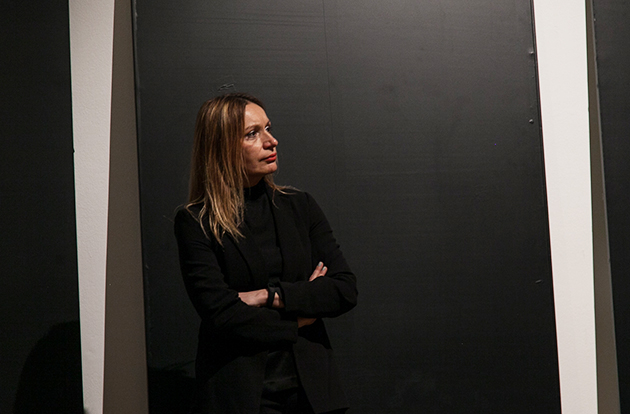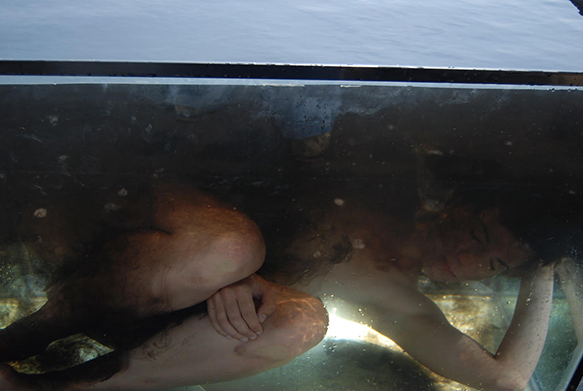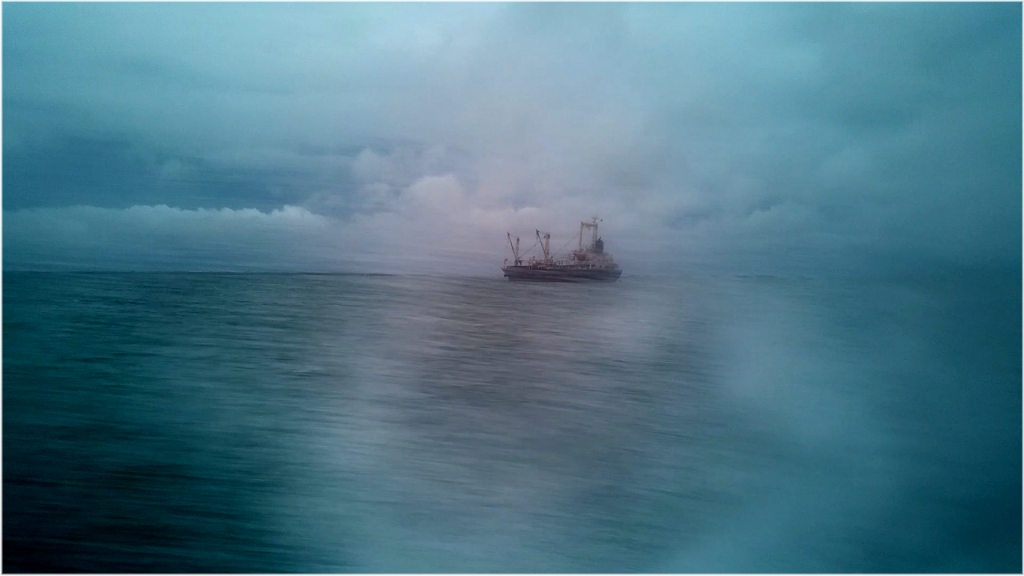DANUBE DIALOGUES 2019/ CENTRAL EXHIBITION
“PERCEPTION OF CONTEMPORANEITY – THE UNIVERSAL SEA”
Museum of Contemporary Art of Vojvodina
As this year’s Danube Dialogues approach we are talking with the art historian, Sanja Kojić Mladenov, PhD, a senior curator at the Museum of Contemporary Art in Novi Sad, who is the curator of the Central Exhibition of the Danube Dialogues 2019 together with Nicole F. Loeser.

Photo: Marko Ercegović
- Mrs Kojić Mladenov, what makes the concept of this year’s Central exhibition special? Can you tell us more about the strategy of Your curatorial thinking regarding the Central Exhibition at this year’s Danube Dialogues?
In the period of contextuality of art, its dependence on interpersonal relations and the connection between art and reality open to discussion, the materiality of the artwork is not in the forefront, but rather its broken form, which rests on the idea, position, concept, as well as audience. The utterly vast and elusive art scene does not represent common ideas of the meaning of existence, but rather focuses on the many diverse existential conditions of multicultural and global world. Simultaneously, the identity of the participants is variable, that is, fluid, created as a result of discursive formations, and we are analysing it in the process of intersecting of its various components, and not their separate observations. The stratification of all these relationships is complemented by the transgression of boundaries, the ideas of breaking formal, media and spatial frameworks, and emphasized interdisciplinarity in art, which makes the curatorial work more demanding and more open to acquiring new knowledge and phenomena, with an emphasized need for communication and networking with international protagonists from the artistic as well as scientific and technological fields. Due to this relativity of the process, contemporary art takes on more and more diverse interpretations, divergent followers and advocates, which is why the issues such as: what makes contemporary art and who are the curators and artists become necessary nowadays in the turbulent period.
The connection between art, nature, science and technology, present in many contemporary art theories and practices, as evidenced by individual experiments and many recent international festivals, publications and events present on the regional and international art scene, constituted the initial concept of the Central Exhibition of the Danube Dialogues 2019 Festival.
The idea is in communication, rivers connect people, they resemble to a bloodstream (Bogdanka Poznanović, 1971), these are the words of a neo-avantgarde, intermedial artists from Novi Sad, who finds the experimentation, interdisciplinary approach, innovating of artistic-scientific techniques and methods, testing new contents, critical observation of modern society, scientific discoveries and closed systems important and they also make the methodological framework of my selection. The interest in the issues of impact of the process of industrialization of society, urbanization, economic and technological development on the nature, on the simplicity of life in the natural environment, water that connects us, the universal sea, are the topics of contemporary ecology and environmental protection, as well as the current artistic practice.
- In your doctoral thesis, You are dealing with discourses on gender in art. To what extent, in Your selection, are the female authors represented at the Central Exhibition of the Danube Dialogues?
The topic of my doctoral thesis was dedicated to the professional identity of female artists dealing with new technologies in Vojvodina, which prompted me to explore the historical and artistic continuity of media and postmodern phenomena, personalities and approaches, but also to conduct an empirical research on the position of women in contemporary art and the consideration of feminist art theory and practice. An interdisciplinary approach has provided me with new insights on the issues and needs present at the art scene, as well as the alternatives important for their overcoming. For the needs of the selection of artists for the Central Exhibition of the Danube Dialogues, starting from the concept turned to intersecting of science, art and technology through the common topic of the Universal Sea, I chose mainly the authors who are close to this topic and who have been dealing with these and similar concepts in their early artistic practice already.
The interaction between the machine – space / sound / light – man and/or plant, animal and nano organism is increasingly present in contemporary art practice through critical analysis of traditional knowledge and the desire to question various phenomena and relationships from climate conditions, spatial limitations, light and sound phenomena to the relationship between “living” and “inanimate” nature, mutations of organisms, biodiversity and life cycle. For many years now, Robertina Šebjanič has been focused on examining the relationships between space, sound, light, water and natural organisms. In the work titled Sound Disposition/Crystal Gardens (2019), together with Aleš Hieng-Zergon and Ida Hirschenfelder, she analyzes the connection of the sound with crystals, with constants such as: man, time, space and technology, but also an element of randomness and uncertain future. These male and female authors are engaged in re-designing of imposed mechanical devices, exploring of connections between man and technology, to which Albena Baeva is also dedicated, through a performative and interactive approach. In the work Civils Part II (an idea about Sibyl and “humanity”), an interactive video installation, she questions the truthfulness of information that is distributed to mass media about climate change and propaganda that dominates the Internet about the relationship between man, technology and nature, which is lifting the responsibility from people for endangering nature and the changes brought about by the industrialization of the society. Sanja Latinović deals with examining the human body’s capabilities in challenging situations through a radical performance practice. In the work titled Aquarium, in a position similar to the human fetus, the author dwells for several minutes in a water-filled aquarium while ink is poured into it, indicating the naivety of man in relation to climate changes, possible metamorphoses and changes that follow the pollution of water. At the same time, an artist Lana Čmajčanin, who focuses on exploring geopolitical and climate positions of power, sets the maritime horizon as the central theme of her work A Change Is Gonna Come II, asking whether the sea is a place of rest and contemplation, a mass grave of migrants, a place of political power and national borders or a place of hope and utopia.

Courtesy of the artist

Courtesy of the artist
- It is known that you are collaborating with the Goethe Institute, that in cooperation with British Council, You were the curator of exhibitions of Demian Hirst and Grayson Perry, in the Museum of Contemporary Art in Novi Sad, that you are an artistic director of the international Risk Change project, also You were the curator of exhibition of Oleg Kulik. Within the Danube Dialogues You are co-operating with the curator Nicole F. Loeser. How significant is the international cooperation in Your curatorial practice?
Over the years, I have developed an increasingly active collaboration with the international art scene in various ways, through projects organized together with foreign cultural institutions, such as Goethe Institute, IFA, British Council and French Institute; furthermore, through exhibitions abroad where I represented important stakeholders and phenomena of artistic practice from Serbia, as well as through international projects supported by the EU, which enable joint work with international organizations on various researches, development of new Internet platforms, exchange of contents, etc. I also held a number of lectures and presentations, participated in residential programmes and in research projects of international partners.
I have organised several guest exhibitions abroad, among which I would like to point out the cooperation with Japan and Taiwan, which have been an exceptional experience in familiarizing with different environments and artistic practices important for extending the horizons and acquiring new knowledge. The above-mentioned guest exhibitions of the great artistic names of the global art scene, such as Demian Hirst and Grayson Perry, as well as Nam June Paik, Joseph Kosuth, Rosemarie Trockel and others, were extremely visible in the media, and enabled the local audience to get acquainted with current art practices, but also to raise questions about power positions and economics in art. Of particular importance is also the restoration of a network of associates from the region of the former Yugoslavia with whom we share a close artistic and social experience, and in recent years I have participated in many regional meetings and projects.
After the long confinedness and isolation of our society from the international artistic streams, such cooperations are of great importance because they enable the affirmation and visibility of the local art scene abroad, local presentation of new contents, the experiences of working together, knowledge about new work methodologies, phenomena, practices, etc. Each of these projects brings a new, different experience from the previous, new challenges and aspirations, and also opens the door to new communications and exchanges that expand the network of associates.
Ljiljana Maletin
Sanja Kojić Mladenov (1974), PhD, senior curator, art historian and researcher in the field of recent artistic practice, media and gender, since 1995. Graduated from History of Art department at the Faculty of Philosophy in Belgrade and completed postgraduate master and PhD Interdisciplinary Gender Studies at the University of Novi Sad (ACIMSI). Director (2013-2016) and Senior Curator at the Museum of Contemporary Art Vojvodina, Novi Sad since 2006, where run the Department of Current Art Exhibitions and Center for Intermedia and Digital Art. Winner of the “Lazar Trifunović Award” of the Society of Art Historians of Serbia, the Department of Modern Art – Faculty of Philosophy in Belgrade and the Cultural Center of Belgrade, for the best critical art practice and critical review of the contemporary scene in Serbia in 2016, as well as the award of the Society of Art Historians of Serbia for the best author exhibition in 2013. Curator of Serbian Pavilion on 54th Venice Biennale of Contemporary Art in 2011 and exhibition Light and Darkness of Symbols, Dragoljub Raša Todosijević, winner of the the UniCredit Venice Award. A member of international associations – AICA, ICOM and CIMAM (Scholarship holder for 2011). She is the author and curator of many thematic exhibitions and research projects in Serbia and abroad, as well as international and EU projects Performing the Museum and Risk Change. Writes and publishes more than 100 critical essays, exhibition reviews and scientific articles in monograph publications, encyclopedias, exhibition catalogues, specialized magazines, books and on the electronic media. Took part in numerous professional presentations, symposiums and conferences in Serbia and abroad.
